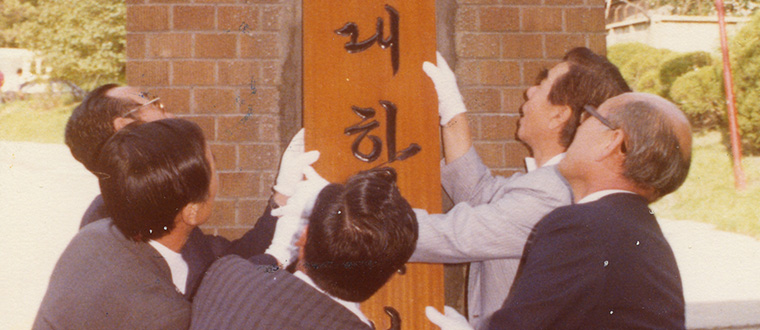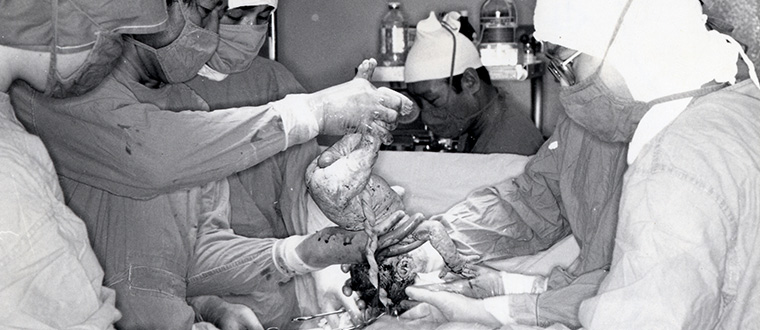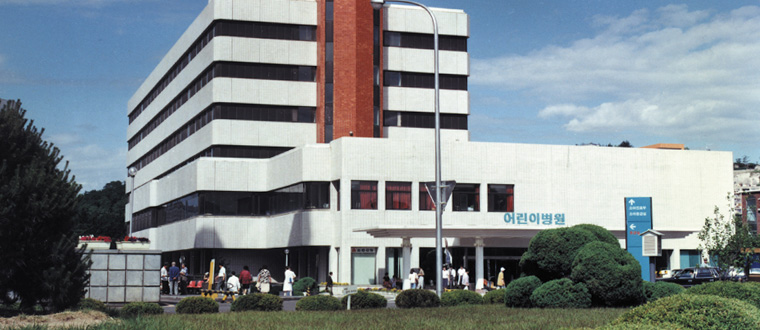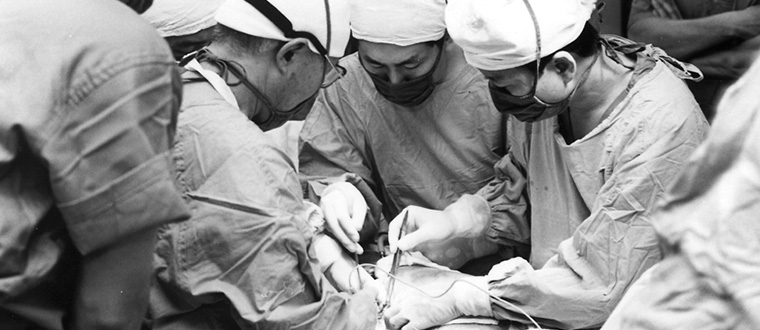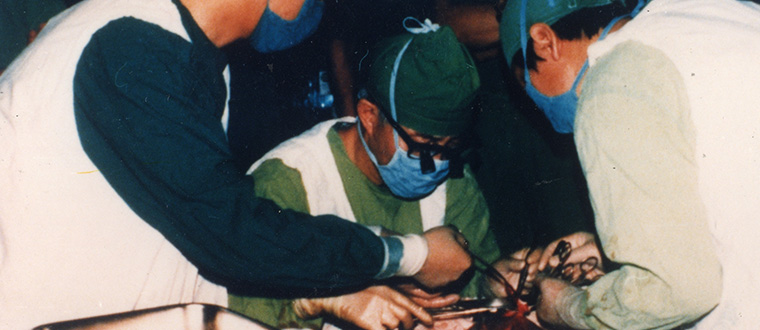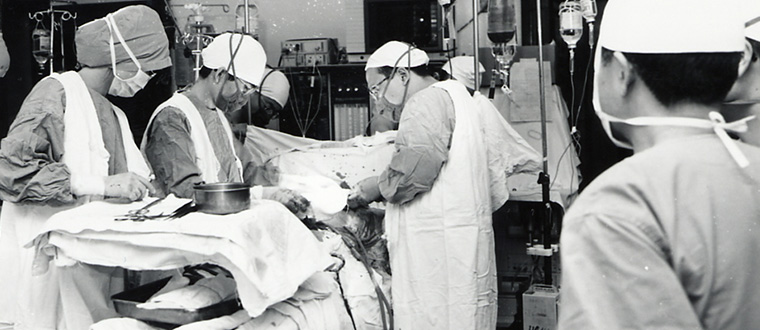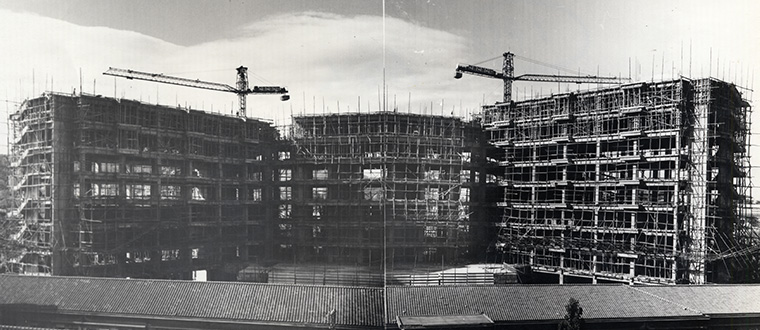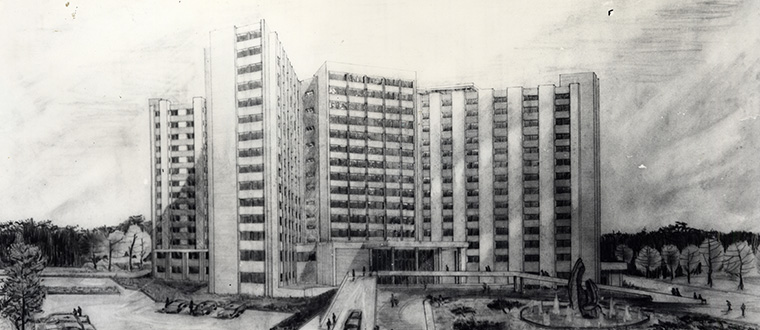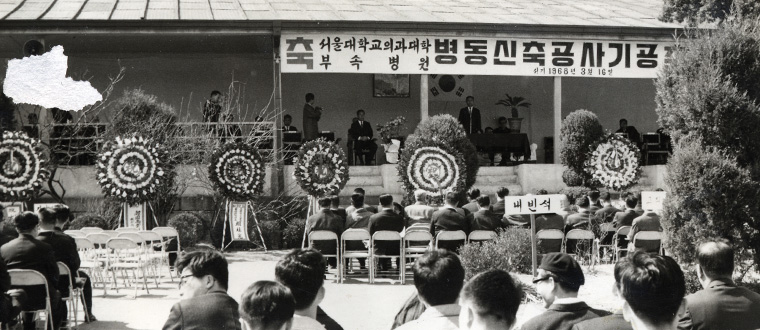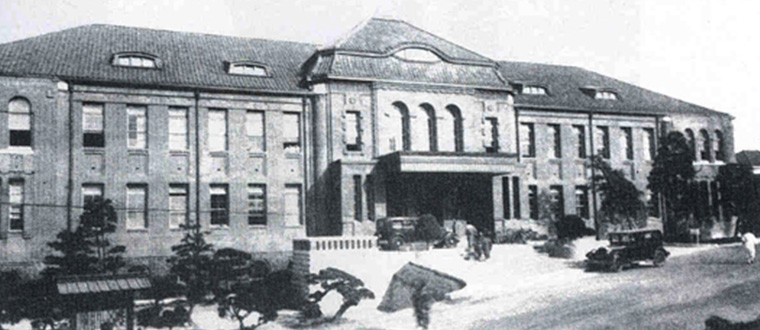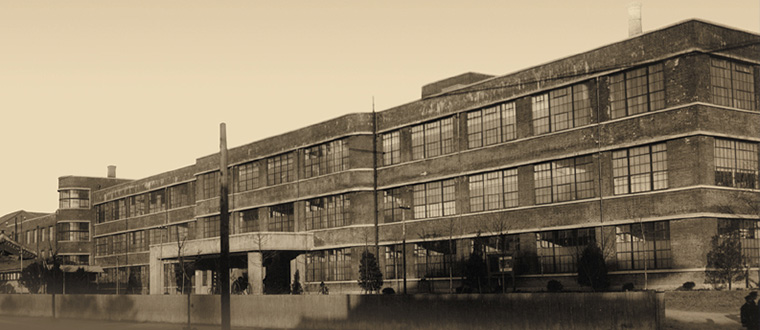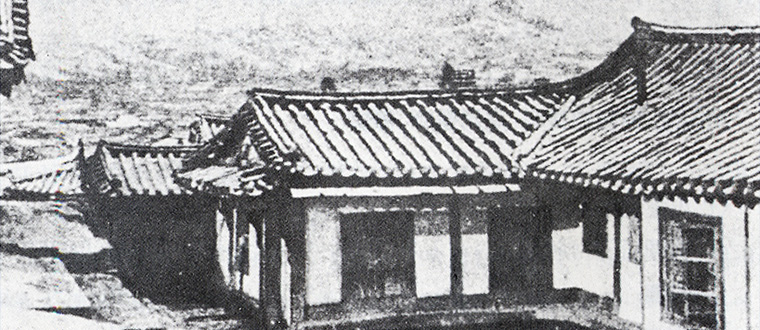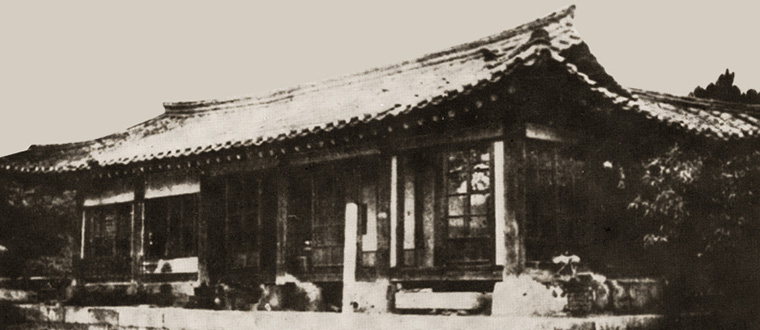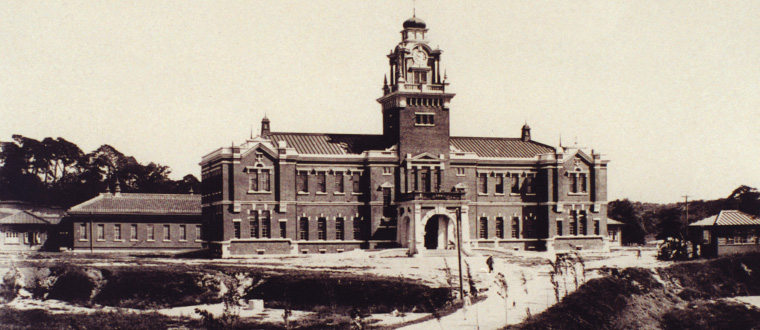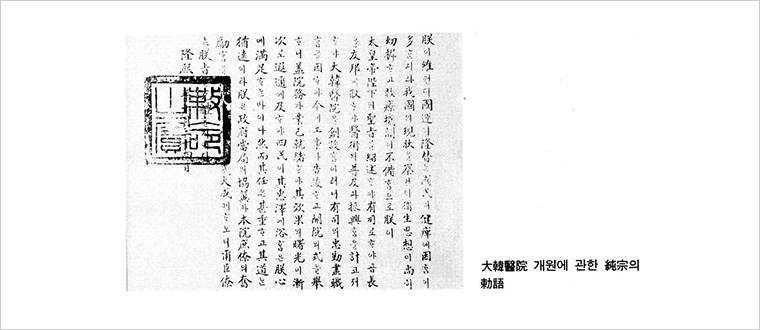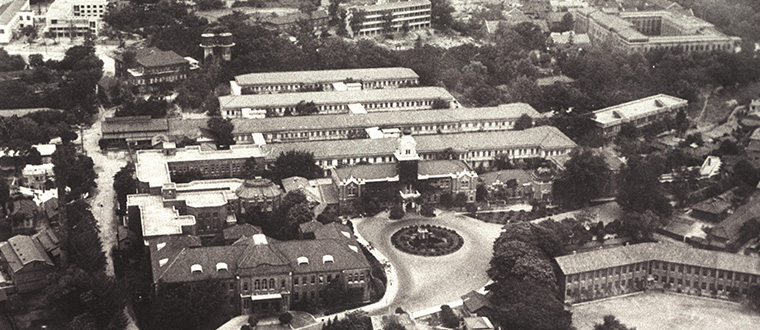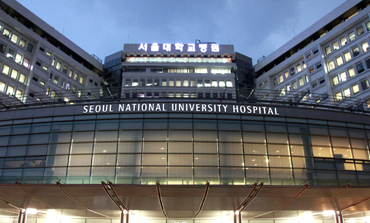
1978~2002
Launched SNUH as a special corporation.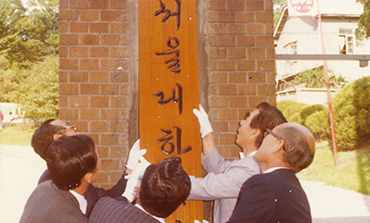
1945~1978
The Hospital affiliated with the College of Medicine of SNU leads the developmentof medical service in South Korea.
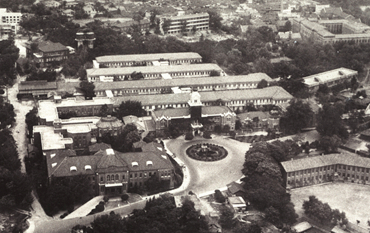
1910~1945
The Japanese Occupation of Korea, the Hospital affiliated with the Medical School of Gyeongseong Imperial University, and the Hospital affiliated with Gyeongseong Medical College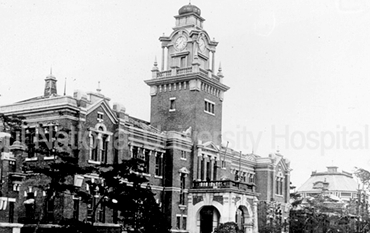
1885~1910
The Joseon Government’s Pursuit of Modernization, and Jejung Hospital and Daehan Hospital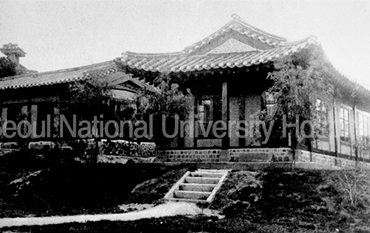
2002 ~ Present
In 1978, the Hospital affiliated with the College of Medicine of SNU was reborn as SNUH, a special corporation, to raise medical service in South Korea to world-class levels by maximizing its autonomy and efficiency. Article 1 of the Establishment of the Seoul National University Hospital Act, legislated at that time, reads, "The purpose [of the present Act] lies in promoting the development of medicine and contributing to the improvement of the national public health by establishing Seoul National University Hospital and providing education, research, examination, and treatment in medicine and dentistry.” The clear implication of this is that SNUH was officially and legally recognized as the center of national medical service.
At the same time as its incorporation, the new hospital building, a long-cherished dream of SNUH, was finally completed. With 1 floor underground and 13 floors aboveground and hospitalization and examination facilities including 1,056 beds and a capacity for over 2,000 outpatients, it was the largest hospital in Northeast Asia at the time. In this way, SNUH consolidated its basis as the representative hospital of South Korea, and its role as the hub of medical research.
Since then, SNUH has pioneered medical service in South Korea by launching the Children's Hospital in 1985, operating the Seoul Metropolitan Government-SNU Boramae Medical Center on consignment in 1987, establishing SNU Bundang Hospital specialized in elderly and adult diseases and SNU Hospital (Health Care System) Gangnam Center specialized in health checkups in 2003, and opening the Cancer Hospital in 2011 to become a global leader in the fight against cancer.
In terms of medicine and medical practice, SNUH has been responsible for many medical ‘firsts’ in Korea, including the first successful delivery of a test tube baby, as well as the first liver transplantation, partial liver transplantation, and non-heart-beating donor liver transplantation. In addition, it has developed the world’s smallest artificial heart. SNUH researchers also successfully isolated the hepatitis C virus serum and developed a new liver cancer test method, both of which were world firsts. SNUH was also the world's first single institution to perform 20,000 gastric cancer surgeries, and 10,000 thyroid cancer surgeries. With these achievements, SNUH is breaking new ground for South Korean medicine. In terms of medical research, the medical staff at SNU College of Medicine and SNUH published more than 1,000 papers in academic journals registered in the Science Citation Index (SCI) in a single year for the first time in 2005, then went on to top this by publishing 1,620 SCI-registered papers in 2010, showing substantial growth. In addition, SNUH formed the Public Health Medical Services in 2006 and has engaged in medical volunteer service for medically underprivileged groups, both domestically and internationally.
In conclusion, SNUH not only faithfully plays a role consistent with its reputation as the national central hospital of South Korea, but has also been working continuously to bring medical service in South Korea to a world-class level.
- May. 22 Started construction of annex building for the Children's Hospital.
- Jun. 01 Started operation of electronic administrative system (groupware).
- Jul. 01 Started implementation of online medical care reservation.
- Oct. 05 Started operation of unattended drug prescription issuing machine.
- Oct. 25 Visited University of Tokyo Hospital in Japan for benchmarking.
- Oct. 28 Created home nursing team.
- Nov. 18 Won Minister of Planning and Budget’s prize in the Public Sector Innovation Contest.
- Dec. 04 Completed construction of SNU Bundang Hospital.
- Jan. 02 Started providing one-day medical care for non-Seoul residents, the elderly, the disadvantaged, etc..
- May. 05 Ceremony held to declare the first year of children’s safety.
- May. 10 Started fully providing medical care at SNU Bundang Hospital.
- May. 13 Started issuing ‘Health One Card,’ a healthcare smart card.
- Aug. 01 Established customer consultation room for outpatients.
- Sep .03 Ceremony held to declare C-lover (Customer-lover) nursing.
- Oct. 14 Opened SNU Hospital (Health Care System) Gangnam Center.
- Dec. 10 Led creation of the world's first pig for organ production, and a cow with resistance to mad cow disease.
- Jan. 13 Created cancer center equipped with the national largest anti-cancer therapy facilities.
- Feb. Led study to establish the world's first cloned human embryonic stem cells.
- Mar. 02 Opened breast treatment center.
- Apr. 28 Extended and reopened emergency medical center for Seoul.
- May. 16 Concluded agreement on healthcare technology cooperation with Joseon Medical Association in North Korea.
- May. 31 Seong, Sang Cheol appointed as the 13th and 14th president.
- Jun. 23 Ceremony to declare Ethics Charter for Healthcare Information and associated symposium held.
- Jul. 07 Concluded partnership agreement with 28 hospitals in South Korea.
- Sep. 27 Ceremony to declare Mother’s Love Practicing Hospital and associated symposium held.
- Oct. 15 Started full operation of EMR (electronic medical records).
- Oct. 29 Held ceremony to declare SNUH as a digital hospital and associated symposium.
- Nov. 01 Telephone exchange number changed from 760 and 708 to 2072.
- Dec. 29 Urgently dispatched 20 medical workers to Sri Lanka to aid tsunami victims.
- Jan. 27 Extended and reopened the emergency medical center.
- Mar. Ranked 1st in brand power for 5th straight year, as evaluated by Korea Management Association Consulting.
- Apr. 01 Started operation of a call center (1588-5700).
- Apr. 13 Selected by Ministry of Health and Welfare as the most outstanding emergency medical center.
- Apr. 14 Ranked 1st by Ministry of Health and Welfare in medical institute evaluation.
- May. 24 Held ceremony to mark Department of Nuclear Medicine’s designation as the IAEA (International Atomic Energy Agency)'s only nuclear medicine partner center in the world.
- May. 25 Held ceremony to open the nation’s first dyskinesia center.
- Jul. 01 Launched business promoting group to celebrate the 100th anniversary of Daehan Hospital and the 122nd anniversary of Jejungwon.
- Oct. 15 Marked 20th anniversary of Children's Hospital.
- Oct. 19 Opened Global Stem Cell Hub.
- Oct. 27 Ceremony held to mark the completion of construction of Pyeongyang Medical Cooperation Center.
- Feb. 06 Opened Diabetes & Thyroid & Endocrine Center.
- Mar. Ranked 1st in brand power for 6th straight year, as evaluated by Korea Management Association Consulting.
- Mar. 15 Held symposium to mark the 99th anniversary of Daehan Hospital.
- Mar. 17 Held Organ Transplantation Center symposium (Achieved 1,000th kidney transplantation since first case in 1969).
- Jul. 13 Implemented 'I-First,’ a customer satisfaction campaign.
- Jul. 14 Opened the Stroke Clinical Research Center, designated by the Ministry of Health and Welfare.
- Jul. Extended the Neonatal Intensive Care Unit to make it the nation’s largest.
- Oct. 12 Held launch ceremony for Six Sigma Project Phase 1.
- Dec. 06 Concluded agreement with Nonghyup on volunteer medical service in rural areas.
- Dec. 13 Declared new vision BREAKTHRU 21.
- Feb. 08 Created Innovative Research Institute for Cell Therapy designated by the Ministry of Health and Welfare.
- Feb. 21. Marked 10th anniversary of opening the Clinical Trial Center.
- Mar. 15 Ceremony held to celebrate the 100th anniversary of Daehan Hospital and 122nd anniversary of Jejungwon.
- Mar. Performed 20,000th gastric cancer surgery.
- Apr. 12 Launched volunteer medical service team for the medically unprivileged.
- Jun. 22 Acquired Full Accreditation from AAALAC (Association for Assessment and Accreditation of Laboratory Animal Care).
- Jul. 01 Created Hospital History and Culture Center.
- Oct. 15 Published the first electronic company magazine, e-Hamchoon Clock Tower.
- Nov. 08 Signed contract on medical exchange with the National Hospital of Mongolia.
- Feb. 04 Concluded MOU on establishing a training center with the City of Mungyeong.
- Feb. 14 Opened the Neuropsychiatry Health Center.
- May. 15 Marked 10th anniversary of Clinical Medicine Research Center.
- May. 26 Opened Robotic Surgery Center.
- Jun. 06 Published first webzine for website members.
- Jun. 18 Opened new hospital in Boramae Medical Center.
- Jul. 22 Performed Korea’s first successful non-heart-beating donor liver transplantation.
- Aug. 04 Remodeled the Children's Hospital.
- Oct. 01 Started construction of Cancer Center.
- Jan. 14 Selected as national standard reference data center.
- Feb. Selected as Breast Cancer Transitional Research Center by the Ministry of Health and Welfare.
- Mar. 02 Started operation of NEW-CRIS, the clinical medicine research management system.
- Apr. 27 Concluded agreement with the Ministry of Justice on remote video medical care for people in correctional facilities.
- May. 07 Korea Organ Donation Agency established.
- Jun. Drug Safety Monitoring Center established.
- Jun. 29 Electronic Medical Record(EMR) System received international certification(ISO27001) in information protection management.
- Jul. 03 Opened the Primates Research Center designated by the Ministry of Health and Welfare.
- Jul. 03 Confirmed suspension of meaningless life-extending therapies.
- Aug. 17 Extended and reopened the Center for Health Promotion and Optimal Aging.
- Dec. 21 Concluded MOU with US Army Medical Corps in Korea.
- Feb. 11 Held ceremony to launch construction of new building for SNU Bundang Hospital.
- Mar. 08 Ranked 1st in brand power for 10th straight year, as evaluated by Korea Management Association Consulting.
- Mar. 09 Built new building for SNU Healthcare Information Center, and moved Center to the new building.
- Apr. 06 Extended the main building lobby.
- May. 31 Jeong, Hee Won appointed as 15th president.
- Jun. 24 Opened mobile reservation website.
- Jul. 09 Primates Research Center achieved full AAALAC accreditation.
- Jul. 15 Concluded agreement with Korea Foundation for International Healthcare to promote Lee Jong-Wook Seoul Project.
- Aug. 30 Ranked 1st in National Brand Competitiveness Index in the general hospital category.
- Sep. 20 Held ceremony for moving and opening the IHC (International Healthcare Center).
- Oct. 06 Selected as prime site (Quintiles).
- Oct. 11 Concluded MOU with Yanji Zhongyi Hospital and Yanji City, China on the establishment of a 'Comprehensive Health Screening Center’.
- Oct. 20 Completed remodeling of the Hope Building at SNU Boramae Medical Center, Seoul.
- Nov. 01 Concluded MOU with National University of Laos on long-term support.
- Jan. 27 Acquired Certificate of Medical Institution from the Ministry of Health and Welfare for the first time.
- Feb. 11 Performed 1,500th kidney transplantation.
- Mar. 08 Ranked 1st in brand power for 11th straight year, as evaluated by Korea Management Association Consulting.
- Mar. 25 Opened SNU Cancer Hospital.
- Apr. 01 Selected as ‘Company with Excellent Gender Equality Culture’ and won prime minister’s citation.
- Apr. 11 Held plaque hanging ceremony for Biomedical Research Institute May Building remodeled to provide a patient-focused, state-of-art lobby.
- Jun. 01 Opened Severe Trauma Center.
- Jun. 23 Implemented SNUH World Class Center Certificate System.
- Jul. 20 Performed 1,000th liver transplantation.
- Aug. 04 SNUH declared first integrated HI.
- Aug. 29 Ranked 1st in National Brand Competitiveness Index in the general hospital category.
- Oct. Concluded MOU with SK Telecom on establishing a joint venture for the national first healthcare fusion technology research and development.
- Oct. Launched mobile application titled ‘Cancer information appropriate for me’.
- Nov. Added 4 operation rooms dedicated to the Cancer Hospital.
- Dec. 13 Opened Breast & Thyroid Center.
- Dec. 21 Held consultation with first patient from Health Authority Abu Dhabi (HAAD), UAE.
- Dec. Performed 10,000th thyroid surgery and 1,000th robot-aided thyroid surgery.
- Jan. 03 Biomedical Research Institute becomes first institute in Korea to be designated as an ‘Excellent Laboratory Animal Facility’ .
- Jan. 17 Launched ‘Health Connect’ for smart mobile health.
- Jan. Performed 10,000th brain tumor surgery.
- Feb. 28 New York Office (U.S.) opened.
- Mar. Ranked 1st for 12th straight year in brand power in the general hospital category.
- Apr. Concluded agreement on emergency healthcare system with National 119 Rescue Headquarters.
- May. 16 Started construction of SNU Cardio-cerebrovascular Hospital.
- Jun. Selected by Fortune Korea as ‘2012 World-class Brand’ in the hospital category.
- Jul. Selected by Ministry of Health and Welfare as rare disease research center.
- Aug. Ranked 1st for 3rd straight year in the National Brand Competitiveness Index.
- Aug. 14 Evaluated as the most outstanding regional emergency medical center for 6th straight year.
- Sep. Issued the SNUH magazine, Hamchoon Clock Tower issue no. 400.
- Sep. Given highest grade across all areas for appropriateness of medical care expenses.
- Sep. 02 Opened HPRT Center.
- Oct. 04 Extended and reopened library as ‘Hamchoon Library’.
- Oct. 10 Started construction of ‘Medical HRD Center,’ the SNUH training center 10. Published the first VOM, the SNUH company newsletter.
- Nov. 16 Clinical Trial Center selected as ‘Global Center of Excellence for Early Clinical Trials’.
- Dec. 20 Opened Walk Assist Robot Rehabilitation Center.
- Dec. Acquired international accreditation from AAHRPP.
- Jan. Selected as 2012 ‘Excellent Institution’ in the public institution customer satisfaction survey for 2nd straight year.
- Jan. 18 Won '2012 BEST ACLS (KALS) TRAINING SITE AWARD'.
- Jan. SNU Cancer Hospital concluded MOU on mutual research cooperation with National Cancer Institute, USA.
- Feb. 21 Built a next-generation network infrastructure for smart mobile medical care environment.
- Mar. 04 Ranked 1st in brand power for 13th straight year by Korea Management Association Consulting.
- Mar. Ministry of Health and Welfare evaluates SNUH as highest-grade emergency medical center for 9th straight year.
- Apr. Selected as ‘research-driven hospital’ by the Ministry of Health and Welfare.
- Apr. 10 Won presidential citation in '2013 Medical Korea’.
- May 02 Opened children’s library for child inpatients.
- May 31 Oh, Byeong Hee appointed as 16th president.
- Aug. Ranked 1st for 4th straight year in the National Brand Competitiveness Index.
- Sep. 11 Extended and reopened the children’s emergency medical center.
- Dec. Won Minister of Education’s prize in 2013 Korea Donation for Education Award.
- Mar. Started the Communication Enhancement Project, SNUH Relating+.
- Mar. Ranked 1st in brand power for 14th straight year by Korea Management Association Consulting.
- Jun. Obtained consignment operating project of Sheikh Khalifa Specialty Hospital (SKSH), UAE.
- Jun. Signed 70 billion KRW contract to export hospital information system to Saudi Arabia.
- Jul. Upgraded Adult Emergency Medical Center.
- Jul. Created SNUH Podcast, SNUH Health Talk Talk.
- Aug. 13 Concluded main agreement on managing UAE Royal Hospital.
- Sep. 25 Opened Human Resources Development Center.
- Sep. Performed 1,000th living-donor liver transplantation.
- Sep. Selected by the Ministry of Health and Welfare as institution to perform ‘Research-driven Hospital Growth and R&D Support Program’.
- Dec. Reobtained Certificate of Medical Institution 2 years after first obtaining it.
- Feb. 18 Opened the UAE hospital under the operation and management of SNUH.
- Mar. 10 Ranked 1st in brand power for 15th straight year by Korea Management Association Consulting.
- Mar. Earned highest grade in the public institution customer satisfaction survey for 4th straight year.
- Mar. Performed 2,000th kidney transplantation.
- Apr. 14 Opened Customized Cancer Treatment Center.
- Apr. 29 Opened Flower Seed Shelter.
- Apr. 30 Held ceremony to celebrate the 130th anniversary of Jejungwon.
- Jun. Held ceremony to celebrate the 3rd anniversary of the Healthy Neighbor Center.
- Jul. 16 Opened CMI Center.
- Jul. 17 Concluded MOU with the City of Yueyang, China to promote the establishment of an international hospital.
- Oct. Held ceremony to celebrate 30th anniversary of Children’s Hospital.
- Nov. Opened SNUH Brain Bank.
- Dec. Started construction of state-of-art outpatient center.
- Mar. Ranked 1st in brand power for 16th straight year by Korea Management Association Consulting.
- Apr. 01 Held commemorative lecture to celebrate the 131st anniversary of Jejungwon.
- Apr. Reselected as research-driven hospital.
- Apr. 30 Held ceremony to celebrate the 131st anniversary of Jejungwon.
- May 31 Seo, Chang Seok appointed as the 17th president.
- Aug. Ranked 1st in the National Brand Competitiveness Index for the general hospital category.
- Sep. Signed agreement between SNUH and SKSH, UAE for teleconsultation service to provide SKSH doctors with second opinions.
- Feb. 01 Started operation of Comprehensive Nursing Care Services.
- Mar. 16 Ranked 1st in brand power for 17th straight year by Korea Management Association Consulting.
- Aug. 13 Marked 3rd anniversary of consignment agreement with SKSH, UAE.
- Aug. 16 Implemented project for In-depth treatment.
- Aug. 22 Established Physician Occupational Ethics Committee.
- Aug. 28 Ranked 1st in the National Brand Competitiveness Index by Korea Productivity Center.
- Sep. 21 Signed MOU on promotion of the cadmium accelerator business.
- Sep. Renewed the Regional Emergency Medical Center and implemented system to enable a group of professors to fully take charge of ER services.
- Sep. Remodeled MICU into a quarantined one-bed ward.
- Oct. 20 Signed MOU on medical support at the PyeongChang Winter Olympics and Paralympics.
- Oct. 24 Renewed the SNUH website.
- Nov. 01 Opened Human Rights Center.
- Nov. 14 Opened Precision Medical Center.
- Dec. 14 Unified the representative telephone numbers into one (1588-5700).
- Jan. Introduced Syapse as SNUH's Cancer Precision Medical Platform.
- Feb. Marked 3rd anniversary of opening SKSH, UAE.
- Feb. Provided medical support for PyeongChang Winter Olympics.
- Mar. 11 Performed Korea’s first successful transplantation of adult lungs into a pediatric patient.
- Mar. 22 Ranked 1st in brand power for 18th straight year by Korea Management Association Consulting.
- Jul. 13 Started full operation of Syapse as SNUH's Cancer Precision Medical Platform.
- Aug. 27 Ranked 1st in the National Brand Competitiveness Index by the Korea Productivity Center.
- Dec. 13 Made all beds in the Pediatric & Adolescent Cancer Center in SNU Children’s Hospital aseptic.
- Feb. 25 Started providing medical care at Daehan Outpatient Clinic.
- Mar. 22 Ranked 1st in brand power for 19th straight year by Korea Management Association Consulting.
- Apr. 03 Opening ceremony of Daehan Outpatient Clinic.
- May 10 Concluded agreement with the Ministry of Science and ICT on the establishment of a baryonic treatment center.
- May 31 Kim, Yeon Soo appointed as the 18th president.
- Jul. 01 Recontracted on and launched SKSH, UAE.
- Jul. 18 Held ceremony to celebrate the 20th anniversary of SNU Children's Hospital School.
- Aug. 13 SNU Healthcare Development Committee appointed.
- Aug. 27 SNU Future Committee appointed.
- Oct. 01 Started consignment operation of National Traffic Injury Rehabilitation Hospital.
- Oct. 24 Concluded agreement with National Health Insurance Service on researching appropriate medical charges.
- Nov. 01 Non-regular, dispatched personnel converted to regular personnel, a first among national university hospitals in Korea.
- Nov. 25 Expanded recruitment of professional hospitalization-dedicated doctors.
- Mar. 04 SNU Human Resource Development Center started operation as Community Treatment Center in Daegu.
- Feb. 01 Started conducting clinical trial on treatment for COVID-19.
- May. 01 Published the Outpatient guide map.
- Jun. 04 Launched the National Bio Big Data Construction Project.
- Aug. 01 Established the Institute of Convergence Medicine and Technology and its department.
- Aug. 22 Operated the residential treatment centers in Nowon and Seongnam-si.
- Aug. 31 RSigned contract for the heavy ion medical accelerator gantry with Toshiba.
- Sep. 14 Ranked No.1 in the National Brand Competitiveness Index for 5 consecutive years.
- Sep. 17 Announced SNUCH 'Vision 2035'
- Nov. 19 Held SNUH Surgical Innovation Forum.
- Dec. 18 Published the Outcomes Book, the Health Care Quality Indicators report.
- Jan. 05 Achieved 1st place in the Anti-Corruption Policy Evaluation.
- Feb. 01 Signed an MOU with Yamagata University.
- Feb. 04Contest of the largest domestic Multi-cinema Wall video works.
- Feb. 26Business agreement among SNUH Developmental Disability Support Center, Korea Disabled People's Development Institute and Seoul National Center for Developmental Disabilities
- Mar. 04Started the COVID-19 vaccination.
- Mar. 25 Ranked No.1 in Korea Brand Power Index for 21 consecutive years by Korea Management Association Consulting.
- Apr. 30 RPassed the final preliminary feasibility test of Baegot SNUH.
- May. 03 Started CAR-T treatment research for pediatric acute leukemia.
- May. 03 SNU cancer research competitiveness ranked 14th in the world.
- Jun. 04 Hosted the signing ceremony of collaborative research with Korea Hydro & Nuclear Power Co.,LTD.
- Jun. 14 Signed an MOU with the National Health Insurance Service for an installation of analysis collaboration center.
- Jun. 30Held a 3-party MOU with 'Invites BioCore', 'Health Connect', and SNUH.
- Jul. 22 Transferred hospital medical technology to Uzbekistan medical team.
- Aug. 6 Signed an MOU with the National Center for Mental Health.
- Sep. 13 Ranked No.1 in the National Brand Competitiveness Index for 6 consecutive years.
- Aug. 6 Signed an MOU with the National Center for Mental Health.
- Nov. 11 Opened the obstetrics and gynecology women's center.
- Nov. 22 Aided establishment of first National University Hospital in Laos.
- Dec. 09 Korea's first hospital produced CAR-T treatment for pediatric leukemia.
- Mar. 02Built a Chatbot for Covid-19 self diagnosis with Kakao co.
- Mar. 07Signed an MOU for regenerative medicine and advanced bio medical products with Daewoong Pharmaceutical and Affyxell Therapeutics.
- Mar. 11Ground-breaking ceremony of Nexon Children's Integrated Care Center.
- Mar. 25Ranked No.1 in Korea Brand Power Index or 22 years by Korea Management Association Consulting.
- Apr. 5Succeeded in hospital-produced CAR-T treatment for the first time in Korea.
- May. 10Collaborated with Kakao Healthcare to establish a 'Precision Medical Knowledge Bank'.
- May. 11SNUCH held a campaign to commemorate the 100th anniversary of Children's Day.
- May. 13Officially opened BestWorks 1.0, the hospital's next-generation groupware.
- May. 19Acquired GMP(Good Manufacturing Practice) Certification of medical software items for the first time in Korea as a medical institution.
- Jun. 20 Decision to consign management of National Fire Hospital.
- Sep. 1Published the Covid-19 White Paper, documenting 2 years and 4 months records.
- Sep. 6 Ranked No.1 in National Brand Competitiveness Index for 7 consecutive years.
- Dec. 23 Obtained the highest grade as a result of the Public Health and Medical Care Plan implementation.
- Feb. 23Establishment of the next-generation medical system based on the Precision Medicine Knowledge Bank.
- Mar. 24Ranked No.1 in Korea Brand Power Index for 23 consecutive years by Korea Management Association Consulting.
- May. 3Agreement with Havard-MIT's HST to train physician-scientists.
- May. 12Held an external representative council meeting of the Seoul Regional Responsible Medical Institution.
- May. 26Held a symposium between SNUCH and the Uzbekistan National Children's Hospital.
- Jun. 19Signed an MOU with the National Medical Center to establish and operate the Central Infectious Disease Hospital.
- Jul. 25Signed an MOU with Seoul Family Court and Seoul Metropolitan Government on entrustment of a treatment center for abused children.
- Aug. 3Launched a research to develop new technologies for decentralized clinical trials.
- Oct. 13Declared SNUH Group 'Mission and Vision',
- Oct. 20Ranked No.1 in National Brand Competitiveness Index for 8 consecutive years.
- Nov. 1Opened the Nexon Children's Integrated Care Center.
- Dec. 19Selected as the best institution for the Public Health Care Plan implementation.
- Dec. 19Signed an MOU with Korea Research Institute of Bioscience and Biotechnology to promote and develop advanced biotechnology research.
- Dec. 21Developed of a standard training program for APN(Advanced Practice Nurse) dedicated to Critical Care.
- Jan. 9First official prescription of Korea's first digital treatment device.
- Jan. 29Designated as Korea's 1st national strategic technology specialized research institute.
- Feb. 7Started to build an extension and remodel SNUH Heavy Iron Therapy Center in Gijang, Busan.
- Mar. 14Acquired the first certificate of AI software medical devices manufacturer as a tertiary hospital.
- Mar. 27Ranked No.1 in Korea Brand Power Index for 24 consecutive years by Korea Management Association Consulting.
- Jul. 26. Launch of the Pediatric Abdominal Ultra-Large AI Data Construction Project.
- Aug. 7. Ranked 1st for 9 Consecutive Years in the National Brand Competitiveness Index (NBCI).
- Aug. 21.Re-contract for the Operation of Sheikh Khalifa Specialty Hospital in UAE.
- Sep. 2.Opening of 'Donghaeng Lounge,' a Complex Space for Cancer Patients.
- Oct. 2.Achievement of INFRAM Level 6 Certification for Medical Information Infrastructure.
- Oct. 21.Report on the Results of the Lee Kun-hee Pediatric Cancer and Rare Disease Overcoming Project.
- Nov. 7. Boston-Seoul Bio & AI Night Event Held.
- Dec. Integration of CDM Data Management Platform by Seoul National University Hospital, Bundang Seoul National University Hospital, and Boramae Hospital.
- Jan. 10Opening of 'Mind the Rest Center,' a Non-Pharmacological Mental Health Treatment Facility.
- Jan. 23 Global Launch of Data Platform for the National Strategic Technology Specialized Research Institute.
- Jan. 23Opening of the Healthcare AI Research Institute.
- Mar. 14Acquired the first certificate of AI software medical devices manufacturer as a tertiary hospital.
- Mar. 21 Seoul National University Hospital & Naver, hosted the Digital & Bio Innovation Forum 2025.
- Mar. 25 Ranked No.1 in Korea Brand Power Index for 25 consecutive years by Korea Management Association Consulting.
- Apr. 4140th Anniversary Academic Lecture of Jejungwon's inauguration.
1978 ~ 2002
In 1978, the Hospital affiliated with the College of Medicine of SNU was reborn as SNUH, a special corporation, to raise medical service in South Korea to world-class levels by maximizing its autonomy and efficiency. Article 1 of the Establishment of the Seoul National University Hospital Act, legislated at that time, reads, "The purpose [of the present Act] lies in promoting the development of medicine and contributing to the improvement of the national public health by establishing Seoul National University Hospital and providing education, research, examination, and treatment in medicine and dentistry.” The clear implication of this is that SNUH was officially and legally recognized as the center of national medical service.
At the same time as its incorporation, the new hospital building, a long-cherished dream of SNUH, was finally completed. With 1 floor underground and 13 floors aboveground and hospitalization and examination facilities including 1,056 beds and a capacity for over 2,000 outpatients, it was the largest hospital in Northeast Asia at the time. In this way, SNUH consolidated its basis as the representative hospital of South Korea, and its role as the hub of medical research.
Since then, SNUH has pioneered medical service in South Korea by launching the Children's Hospital in 1985, operating the Seoul Metropolitan Government-SNU Boramae Medical Center on consignment in 1987, establishing SNU Bundang Hospital specialized in elderly and adult diseases and SNU Hospital (Health Care System) Gangnam Center specialized in health checkups in 2003, and opening the Cancer Hospital in 2011 to become a global leader in the fight against cancer.
In terms of medicine and medical practice, SNUH has been responsible for many medical ‘firsts’ in Korea, including the first successful delivery of a test tube baby, as well as the first liver transplantation, partial liver transplantation, and non-heart-beating donor liver transplantation. In addition, it has developed the world’s smallest artificial heart. SNUH researchers also successfully isolated the hepatitis C virus serum and developed a new liver cancer test method, both of which were world firsts. SNUH was also the world's first single institution to perform 20,000 gastric cancer surgeries, and 10,000 thyroid cancer surgeries. With these achievements, SNUH is breaking new ground for South Korean medicine. In terms of medical research, the medical staff at SNU College of Medicine and SNUH published more than 1,000 papers in academic journals registered in the Science Citation Index (SCI) in a single year for the first time in 2005, then went on to top this by publishing 1,620 SCI-registered papers in 2010, showing substantial growth. In addition, SNUH formed the Public Health Medical Services in 2006 and has engaged in medical volunteer service for medically underprivileged groups, both domestically and internationally.
In conclusion, SNUH not only faithfully plays a role consistent with its reputation as the national central hospital of South Korea, but has also been working continuously to bring medical service in South Korea to a world-class level.
- Jan.11 Established SNUH Establishment Committee.
- Jun. 21 Established and Enacted the Establishment Law of SNUH.
- Jul. 14 Kim, Hong Ki appointed as the first president of the special corporation.
- Jul. 15 Launched SNUH as a special corporation.
- Jul.
17~18 Held an academic seminar to mark the official opening.
- Feb. 05 Started outpatient treatment in the new ward and outpatient reservation system.
- Apr. 01 Published the first hospital magazine.
- May. 28 Kwon, Yi Hyeok appointed as the 2nd president.
- Jun. 01 Computerized hospital affairs.
- Nov. 01 Started referral care system.
- Nov. 20 Published the first weekly magazine (current weekly newsletter).
- Feb. 22 Developed an artificial pancreas, a first in Korea (Department of Biomedical Engineering).
- May. 30 Established affiliated hospital laboratory (previous main building).
- Aug. 05 Hong, Chang Ui appointed as the 3rd president.
- Nov. 20 Published a promotional guide leaflet in Korean.
- Feb. 01 Computerized outpatient payment.
- Aug. 22 Celebrated opening of the management building.
- Sep. 15 Created South Korea’s first Department of Family Medicine.
- Nov. 18 Established the daytime hospital for Department of Neurology and Psychiatry.
- Feb .15 Opened dormitory for nurses.
- Jun. 01 Lee, Yeong Gyoon appointed as the 4th and 5th president.
- Aug. 09 Created short-term training course for medical practitioners.
- Nov. 04 Established the Medical Museum Establishment Preparation Committee.
- Dec. 17 Celebrated the start of building a Children’s Hospital.
- Mar. 09 Established Audiovisual Training Room.
- Jul. 01 Formed team in charge of outpatient services.
- Oct. 11 OECF vice ministers’ agreement between South Korea and Japan on children's hospital concluded.
- Apr. 04 Construction of Clinical Pathology building completed.
- Sep. 03 Conducted audiovisual training on English conversation.
- Nov. 07 Plaque hanging ceremony held for designation as WHO Collaborating Centre for hospital management.
- Aug. 31 Developed a new artificial hip (Department of Orthopedics).
- Oct. 12 Delivered the first test-tube baby in Korea (Department of Ob/Gyn).
- Oct. 16 Opening ceremony held for Children's Hospital.
- Dec. 15 Completed construction of the nuclear medicine examination building.
- Apr. 09 Started providing medical care at Speech & Hearing Disorder Treatment Room.
- May. 28 Han, Yong Cheol appointed as 6th and 7th president.
- Jun. 09 Eye bank officially launched.
- Jul. 01 Started IV injection mixing.
- Aug. 30 Performed 500th female fertility restoration surgery.
- Oct. 14 Established Liver Laboratory.
- Feb. 03 Performed 5,000th open-heart surgery.
- May. Acquired first US certification for a colon cancer cell line (Department of Surgery).
- May. 09 Started employee training.
- Jul. 31 General meeting held on founding a labor union.
- Sep. 24 Delivered first female sextuplets in Korea (delivery of most babies in a single pregnancy based on GIFT method).
- Sep. 26 Concluded consignment contract for management of Municipal Yeongdeungpo-gu Hospital.
- Oct. 26 Unveiled statue of Ji, Seok Yeong (a.k.a. Songchon).
- Dec. 09 Completed repair of Municipal Yeongdeungpo-gu Hospital, and opened hospital.
- Dec. 21 Reissued weekly magazine.
- Jan. 13 Acquired US patent for an artificial heart (Department of Biomedical Engineering).
- Feb. 3 Performed 200th kidney transplantation.
- Mar. 17 Performed Korea’s first successful liver transplant operation (Department of Surgery).
- May. 09 Installed MRI.
- Nov. 18 Successfully transplanted an artificial internal ear (Department of Otolaryngology).
- Feb. 01 Installed Medical Museum under the president of Department 1 of Medical Care.
- Apr. 27 Completed construction to extend the Department of Pediatric Medical Care building.
- Aug. 23 Established clinical professor system.
- Dec. 13 Started repair of facilities and equipment.
- May. 28 Noh, Gwan Taek appointed as the 8th president.
- Jul. 14 Established first summer resort at Naksan Beach in Gangwon-do.
- Nov. 01 Telephone exchange number changed from 7601 to 760.
- Nov. 20 Performed Korea’s first successful fetal blood transfusion (Department of Ob/Gyn).
- Jan. 28 Designated by the Korean Medical Association as pilot institution for doctor training.
- Mar. 05 Launched first national transplantation symposium (8 teams including kidney, liver, heart, etc.).
- May. 20 Established affiliated Clinical Medicine Research Center.
- Jun. 16 Established the nation’s first infection control room.
- Jul. 01 Started diagnosis in the organization and staff.
- Nov. 18 Started providing medical care at the newly built Boramae Medical Center.
- Jan. Introduced computers and started work automation.
- Jan. 25 Opened eastern gate (Daehak-ro gate).
- Apr. 06 Opened Medical Museum.
- May. 18 Performed successful heart transplantation on the youngest patient in Korea (Department of Surgery).
- Jul. 11 Performed Korea’s first successful partial liver transplantation (Department of Surgery).
- Jul. 21 Established Organ Transplantation Committee.
- Dec. 01 General meeting held to establish Hamchoon Supporters Association for Underprivileged Patients.
- Dec. 11 Ceremony held to start construction of the basement parking lot.
- Jan. 11 Concluded agreement with University of Pennsylvania, School of Medicine Philadelphia, Pennsylvania and Pennsylvania Hospital.
- Mar. 30 Held ceremony to celebrate publication of a resident medical care handbook.
- May. 13 Held ceremony to celebrate publication of SNUH’s history.
- May. 18 Completed construction of new building for the Dental Hospital.
- May. 30 Han, Man Cheong appointed as the 9th president.
- Jun. 10 Entire hospital building declared a non-smoking area.
- Jul. 01 Established Patient Comfort Enhancement Committee.
- Dec. 23 Performed Korea’s first successful brain cell transplant surgery (Department of Neurology and Department of Neurosurgery).
- Mar. 30 Performed Korea’s first long-distance heart transplant (Department of Thoracic Surgery).
- May. 07 Established the first national lung transplantation medical care room.
- Jun. 15 Installed Korea’s first PET.
- Jun. 17 Completed repair of the main building wards.
- Jul. 01 Han, Man Cheong appointed as the 9th president.
- Jul. 04 Developed stereotactic system surgery and performed successful surgery (Department of Therapeutic Radiation).
- Aug. 01 Started operation of the polysomnography room.
- Aug. 22 Launched the Bundang Hospital Establishment Promotion Group.
- Sep. Established the nation’s first epilepsy intensive care center.
- Sep. 01 Established male medicine clinic.
- Oct. 14 Established specialized ward for pediatric cancer and leukemia.
- Dec. 17 Completed construction of basement parking lot.
- Oct. 19 Performed the world’s first successful transplant of an artificial heart the size of a human heart in a sheep (Department of Thoracic Surgery, Department of Biomedical Engineering).
- Jan. 06 Moved the president’s room and more to the clock tower building to secure space for outpatient medical care.
- Jan. 10 Established library for patient guardians.
- Apr. 21 Ceremony held to celebrate start of construction of Clinical Medicine Research Center Clinical Trial Center.
- May. 01 Established Center for Health Promotion and Optimal Aging.
- Mar. 01 Introduced system to strengthen qualification requirements, and appointed 6 certified nurses.
- Mar. 02 Started operation of a daycare center.
- Mar. 21 Performed first successful extracorporeal cancer surgery (Department of Urology and Department of Surgery).
- May. 31 Lee, Yeong Woo appointed as the 10th president.
- Jun. 24 Started operation of town shuttle bus.
- Jul. 01 Started computerization of hospital affairs.
- Oct. Started gene therapy in end-stage cancer patients (Department of Oncology Internal Medicine).
- Jan. 25 Launched website.
- Mar. 21 First QA contest held.
- Mar. 27 Celebrated the start of construction of Bundang Hospital.
- Sep. 24 Opened Remote Dementia Center.
- Nov. 20 Started operation of Boramae Medical Center and Remote Diagnosis System.
- Dec. 01 Implemented local blood draw system for patients outside of Seoul.
- Aug. 04 Established outpatient unit for the Department of Anesthesiology.
- Oct. 26 Performed successful simultaneous transplant of a heart and lungs (Department of Thoracic Surgery).
- Nov. 17 Started construction of Cancer Conquest Research building.
- Dec. 06 Established Gamma Knife Center.
- May. 15 Completed construction of the nation’s largest Clinical Medicine Research Center.
- May. 27 Established Eye & Otolaryngology Center on the 2nd floor of the main building.
- May. 31 Park, Yong Hyeon appointed as the 11th and 12th president.
- Sep. Identified the cause of Hodgkin's disease, a world first (Department of Pathology).
- Oct. Developed a new liver tumor test method (Department of Diagnostic Radiology).
- Dec. 14 Completed construction and repair of the outpatient unit for the Department of Internal Medicine.
- Oct. 21 Held public-facing health lecture.
- Nov. 01 Launched a family violence victim protection team (for children), a first in the medical industry.
- Nov. 05 Performed Korea’s first successful lung division transplant (Department of Surgery).
- Jan. Identified the cause of cerebral palsy, a world first (Department of Ob/Gyn).
- Jan. 29 Declared Vision 21.
- Apr. Identified the cause of allergies, a world first (Department of Allergy Internal Medicine).
- Apr. 02 Extended and reopened the Medical Museum.
- Jun. 17 Extended Funeral Service Hall.
- Jul. 15 Established the nation’s first Children's Hospital School.
- Oct. 14 Built a comprehensive healthcare information system.
- Nov. 17 Succeeded in isolating hepatitis C virus, a world first (Department of Gastroenterology Internal Medicine).
- Nov. 22 Won the first prize of Korea Management Association for the hospital category.
- Dec. 27 Comprehensive healthcare information system was selected as one of the top 100 Korean 20th century technologies by the Ministry of Science and ICT, etc.
- Jan. 01 Declared 2000 Medical Care Service Safety (Y2K issue solved).
- Feb. Developed automatic sight examination system (Department of Ophthalmology).
- May. Developed a cure for intractable rheumatism, a world first (Department of Rheumatology Internal Medicine).
- Oct. 14 Completed construction of ‘Hamchoon Shelter’ for patients.
- Feb. Discovered a new HIV sub-type (HIV-1) (Department of Infection Internal Medicine).
- Feb. 21 Opened hospice room.
- Mar. 05 Successfully performed first liver transplant surgery procedure in which only part of the patient's liver is removed before transplanting a part of the donor's liver (Department of Surgery).
- Mar. 21 Ranked 1st in brand power by Korea Management Association Consulting.
- Apr. 04 Service leader launching ceremony held.
- Jul. 01 Started PACS, a purely nationally developed technology.
- Aug. 27 Established genomic center for diabetes and endocrine diseases.
1945 ~ 1978
In 1946, a year after Korea’s Liberation from Japanese rule, SNU was established. At the time, the Medical School of the former Gyeongseong Imperial University and the former Gyeongseong Medical College were combined to launch the SNU College of Medicine, and the Hospital affiliated with the Medical School of the former Gyeongseong Imperial University became the Affiliated Hospital of the College of Medicine of SNU.
Amidst the political and ideological maelstrom that immediately followed the Liberation, the SNU College of Medicine and its affiliated hospital devoted their energy to research, education, examination, and treatment. During the Korean War, they continued to provide medical education by operating the Wartime United University in Busan, and did their utmost to examine and treat local residents and refugees by operating relief hospitals on Jeju Island and in Busan. From 1954 to 1961, they repaired facilities through the Minnesota Project and introduced the latest medicine and medical education methodologies through the faculty members' training in the United States. As a result, departments including the Department of Thoracic Surgery, Department of Neurosurgery, Department of Anesthesiology, and Department of Clinical Pathology came to secure the foundation for development, and the internship/residency system was established. The hospital performed Korea’s first ever open-heart surgery using a cardiopulmonary bypass (CPB) in 1963, and became the first in the world to successfully isolate the hepatitis B virus antigen, developing and commercializing a vaccine during the 1970s.
Ultimately, despite and amidst adverse social conditions including the division of the nation into North and South Korea, war, and economic hardships, the Hospital affiliated with the College of Medicine of SNU led medicine and medical service in South Korea, thus contributing to the national life and social development through the healing arts. In particular, it fulfilled its mission as the central national hospital by faithfully serving as a central base for the introduction and dissemination of advanced medicine, and fostering numerous medical scientists through systematic training, thus allowing them to become medical staff at medical schools across the country.
- Oct. 17 U.S. military government changed the name of Gyeongseong Imperial University to Gyeongseong University, and of the Hospital affiliated with the Medical School of Gyeongseong Imperial University to the Hospital affiliated with the Medical School of Gyeongseong University.
- Aug. 22 Under the order to establish National Seoul University College of Medicine, Gyeongseong Imperial University of College of Medicine and Gyeongseong Medical College were combined to become National Seoul University College of Medicine.
- Aug. 22 Hospital affiliated with the Gyeongseong University (Yeongeon-dong) was reorganized as the First Hospital, and Affiliated Hospital Gyeongseong Medical College (Sokyuk-dong) was reorganized as the Second Hospital.
- Oct. 22 Professor Myeong, Ju Wan appointed as president of First Hospital; Professor Yoon, Chi Wang appointed as president of Second Hospital.
- May 01 Professor Kim, Doo Jong appointed president of First Hospital.
- Nov. 01 Professor Lee, Seon Geun appointed president of Second Hospital.
- Nov. 07 Professor Kim, Dong Yik appointed president of First Hospital.
- Dec. 31 Following the declaration of the Korean Education Law, National Seoul University was renamed Seoul National University.
- Korean War broke out, and many professors including Principal Lee, Gap Soo were kidnapped and taken prisoner by North Korea.
- Hospital affiliated with the College of Medicine of SNU reorganized as the 36th Army Hospital in Busan.
- Feb. 23 Hospital affiliated with the College of Medicine of SNU opened refugee hospital in Hallim, Jeju.
- Jul. Hallim relief hospital closed and joined with Busan team to establish refugee hospital in Shinchang-dong.
- Jan. 20 Professor Jin, Byeong Ho appointed as president of Hospital affiliated with the College of Medicine of SNU.
- Aug. Returned to Seoul and distributed medical instruments, etc. to teachers at the College of Pharmacy and College of Dentistry.
- Oct. 20 Established temporary clinic in the hospital residence.
- Mar. 30 US Army units that had resided in the Hospital affiliated with the College of Medicine of SNU handed over the hospital, and it was officially reopened.
- Sep. Clock tower building repaired.
- Sep. 28 Agreement contract signed with Minnesota to receive technological support (professor exchange, facility and equipment improvement, etc.).
- Sep. Professor Kim, Dong Yik reappointed as president of the Hospital affiliated with the College of Medicine of SNU.
- Dec. Completed extension of West Ward 1 (Department of Ob/Gyn) and West Ward 2 (Department of Pediatrics).
- Department of Surgery divided into Department of Thoracic Surgery, Department of Orthopedics, and Department of Neurosurgery.
- Jan. Department of Anesthesiology separated from the Department of Surgery Internship system launched.
- Mar. First 18 internships completed.
- Aug. 07 Performed Korea’s first open-heart surgery (Department of Thoracic Surgery).
- May 30 Established nation’s first Radioisotope Clinic.
- Oct. 02 Professor Kim, Seong Hwan appointed president of the Hospital affiliated with the College of Medicine of SNU.
- Jan. 04 Management of Second Hospital transferred to the Ministry of Defense (now the Armed Forces Hospital).
- Jan. Started special care system (differentiated general care from special care).
- Oct. 01 Professor Han, Sim Seok appointed president of the Hospital affiliated with the College of Medicine of SNU.
- Jan. 01 Adopted special account system and introduced business accountability system.
- Jul. 22 Completed construction of a special room-dedicated ward.
- Nov. Started design of new building (Whiting came to Korea).
- Dec Started basic construction of the new hospital.
- Mar. 16 Groundbreaking ceremony held for the construction of a new SNUH building.
- Apr. Department of General Surgery, Department of Thoracic Surgery, and Department of Orthopedics separated and started independent operation as individual official departments.
- Sep. 04 Professor Kim, Hong Ki appointed president of the hospital.
- Dec. 20 Department of Neurology and Psychiatry divided into Department of Neurology and Department of Psychiatry.
- Jan. 25 Outpatient clinic destroyed by fire.
- Apr. 30 Outpatient clinic restored.
- Jul. 23 Department of Plastic Surgery separated from the Department of Surgery.
- Dec. 31 Law to Establish Seoul National University Hospital enacted (Law no. 3056)
Professor Kim, Jeong Ryong and his research team successfully isolated hepatitis B virus.
1910 ~ 1945
Executed in 1910, Japan’s annexation of Korea spelled immense disaster for the entire nation in all fields, including politics, the economy, society, and culture. The field of medical service was no exception. Due to Japanese occupation, Korea’s efforts to establish the basis of modern medicine with our own hands were frustrated. Immediately after the annexation, Daehan Hospital was reorganized into Jung'ang Hospital, then into the Government-General of Korea (GGK) Hospital. Likewise, the Medical School affiliated with Daehan Hospital was reorganized as the Medical Training School affiliated with the GGK Hospital. All fields constituting hospitals and medical education including operation, organization, and manpower were changed into a system focused on the Japanese. Except for a minority of ethnic Koreans, all major staff members of hospitals and schools including hospital directors, physicians, professors, pharmacists, assistants, administrative officers, and interpreters came to be replaced by the Japanese.
With the proclamation of the Ordinance on Professional Schools in 1916, the Medical Training School affiliated with GGK Hospital was promoted as Gyeongseong Medical College. The director of the GGK Hospital also served as the dean while the medical officers and physicians from the same institution served as professors, and GGK Hospital came to function as an internship hospital for Gyeongseong Medical College. Following the launch of the Medical School of Gyeongseong Imperial University in 1926, GGK Hospital was reorganized into the Hospital affiliated with the Medical School of Gyeongseong Imperial University in 1928, and Gyeongseong Medical College established its own affiliated hospital separately in Sokyuk-dong, Jongno-gu, Seoul. Although the number of ethnic Korean physicians and medical scientists increased somewhat, all duties continued to be performed under Japanese supervision, making it nearly impossible for ethnic Koreans to become physicians at the affiliated hospitals or professors at the schools. But despite such adverse environments and conditions, the ethnic Korean medical school students and physicians at the Medical School of Gyeongseong Imperial University, Gyeongseong Medical College, and the two affiliated hospitals diligently studied advanced medicine and developed into capable medical specialists who went on to lead South Korean medicine following the Liberation.
- Sep. 02 Daehan Hospital renamed Jung'ang Hospital.
- Sep. 30 Jung'ang Hospital renamed the Government-General of Korea Hospital (GGK); the Medical School affiliated with Jung'ang Hospital renamed the Medical Training School affiliated with GGK Hospital.
- Mar. First graduation ceremony (27 graduates) at the Medical Training School affiliated with GGK Hospital held.
- Mar. GGK Hospital launched dental clinic Both wings of the main building of GGK Hospital (clock tower building) extended.
- Apr. GGK Hospital opened Department of Psychiatry.
- Apr. Medical Training School affiliated with GGK Hospital promoted to Gyeongseong Medical College.
- Apr. GGK Hospital launched department of epidemics and endemics research.
- May. GGK Hospital divided department of surgery and launched a new department of orthopedics.
- Oct GGK Hospital divided the department of internal medicine into departments 1 and 2.
- GGK Hospital started construction of a new outpatient clinic.
- GGK Hospital completed construction of sample outpatient clinic.
- GGK Hospital completed construction of regular outpatient clinic.
- May. 02 Gyeongseong Imperial University of College of Medicine and a preparatory course established.
- Apr. GGK Hospital opens psychiatric ward.
- May 28Administrative law announced to establish Affiliated Hospital of Gyeongseong Medical College.
- May 28 GGK Hospital reorganized into Hospital affiliated with the Medical School of Gyeongseong Imperial University.
- Jun. 21 Opening ceremony held for the hospital of Gyeongseong Imperial University of College of Medicine.
- Nov. 29 Opening ceremony held for the Affiliated Hospital of Gyeongseong Medical College (starting from the Sokyuk-dong, Jongno-gu, Seoul).
- Apr. Phase 1 of construction of the Clinical Research building of the hospital of Gyeongseong Imperial University of College of Medicine completed.
- May 09 Nursing school affiliated with the Affiliated Hospital of Gyeongseong Medical College established.
- Dec. Phase 2 of construction on the Clinical Research building of the hospital of Gyeongseong Imperial University of College of Medicine completed.
- Mar. 01 First graduation ceremony held for Gyeongseong Imperial University of College of Medicine .
- Dec. Construction of an epidemics research room of the Clinical Research building of the hospital of Gyeongseong Imperial University of College of Medicine completed.
- Wards for the Department of Internal Medicine and Department of Pediatrics at the hospital of Gyeongseong Imperial University of College of Medicine reconstructed.
- Wards for the department of ophthalmology and department of dermatology at the hospital of Gyeongseong Imperial University of College of Medicine reconstructed.
- Wards for Department of Otolaryngology, Department of Surgery, and Department of Dermatology at the hospital of Gyeongseong Imperial University of College of Medicine reconstructed Assistant System implemented.
1885 ~ 1910
Following the opening of the nation’s doors to the world in 1876, King Gojong and the government of the Joseon Dynasty established and set out to implement a modernization project on a national scale. Here, they focused also on the modernization of medicine. Consequently, through an inspection party that was dispatched to Japan in 1881, they explored Western medicine, and through the Hanseong Sunbo, the government bulletin, informed the people of the need for Western medical education in 1884. When Robert S. Maclay, an American Methodist missionary, entered Korea and suggested the foundation of a Western-style hospital, he was granted royal permission. Later in 1884, the Gapsin Coup was executed. In the course of events, Horace N. Allen, an American physician-missionary, saved the life of Min, Yeong Ik, a high-ranking government official who had been stabbed by an assassin. This event served as a catalyst for the opening of a Western-style national hospital.
Finally, in April 1885, King Gojong and the Joseon government established Jejung Hospital ("House of Universal Helpfulness") under the Board for General Control of Diplomatic and Commercial Matters (equivalent of the present-day Ministry of Foreign Affairs and Trade (MOFAT)). They provided all of the land, buildings, facilities, administrative workers, and operating funds, and employed American physicians to examine and treat patients. Of course, the overall management and supervision of Jejung Hospital were the responsibility of government officials. For this reason, missionaries at the time likewise alluded to Jejung Hospital in diverse reports as a "government hospital.” Ultimately, Jejung Hospital became the first Western-style national hospital to be established and operated by the Joseon government in Korea.
King Gojong and the Joseon government gave two special missions to Jejung Hospital, which was the national hospital. The first consisted of teaching Western medicine to intelligent young men so that they would become competent medical specialists. The second consisted of treating impoverished patients free of charge. Already at the time of Jejung Hospital, the advancement of medicine and public medical service were established as the social responsibility of the national hospital. Even after the establishment of the Empire of Korea in 1897, the Korean government continued to maintain the basic goals of the nation's public health and medical service policy as the advancement of medicine and the provision of public medical service. In 1899, it founded Gyeongseong Medical School (forerunner of the present-day SNU College of Medicine), a public institution, to foster physicians, and opened Gwangje Hospital ("House of Extended Helpfulness") as the new national hospital, devoting its energy to the examination and treatment of vulnerable patients and the spread of inoculation.
In 1907, the Empire of Korea established Daehan Hospital by combining Gyeongseong Medical School, and its affiliated hospital, Gwangje Hospital, with the Korean Red Cross Hospital that belonged to the royal household. As a comprehensive medical institution providing education, research, examination, and treatment, Daehan Hospital also served as a public medical institution. Beyond this, it even had the authority to govern the country's medical service and public health projects. With the annexation of the Empire of Korea by Japan in 1910, the project to modernize medicine in Korea was temporarily frustrated. Nevertheless, the experience of modernizing medicine that continued from Jejung Hospital to Daehan Hospital had a considerable effect on the history of medical service in Korea.
- Apr. 14 Gwanghyewon, a public hospital, was established under the competent authority of the Board for General Control of Diplomatic and Commercial Matters
(This was the first modern public hospital of Western medicine in Korea, originally located at Hong, Yeong Sik’s mansion, where the Constitutional Court stands today.) - Apr. 26 Gwanghyewon renamed Jejung Hospital.
- Sep. 26 Management right for Jejungwon transferred to missionary of the American Presbyterian Church.
- Mar. 24 Announced administrative law for a Medical School (First medical education institution, a college of modern medicine that is the forerunner to Seoul National University College of Medicine, originally located at Kim, Hong Jip's mansion in what is now Kwanhoon-dong, Jongno-gu, Seoul).
- Mar. 28Ji, Seok Yeong appointed principal of the Medical School.
- Apr. 24 Established Internal Hospital (All medical staff were initially Oriental doctors; originally located at Sakanwon across from what is now Youngchu Gate of Kyungbok Palace).
- Apr. 26 Choi, Hoon Joo, head of the Internal Hygiene Division, appointed first president of the Internal Hospital.
- Jul. 14 First student recruitment at Medical School started.
- Oct. 02 Opening ceremony held for the Medical School.
- Jan. 15 Lee, Joon Gyoo appointed as the second president of the Internal Hospital.
- Jun. 30 Internal Hospital renamed Bosiwon.
- Jul. 09 Bosiwon renamed Gwangjewon (Relocated to Jae-dong, Jongno-gu, Seoul)
- Feb. 28 Yeom, Hong Dae appointed as president of Gwangje Hospital.
- Jun. 12 Medical School opened an Affiliated Hospital of the Medical School apart from Gwangje Hospital (Located at Hoon-dong, Jongno-gu, Seoul)
- Jan. 09 First graduation ceremony (19 graduates) held at the Medical School.
- Apr. 10 Agreement for the return of Jejungwon concluded between the government and American Presbyterian Mission, and the government redeemed Jejungwon.
- Jul. 11 Government paid 1,700 KRW to redeem Jejungwon.
- Aug. Established Oriental pharmacy, western pharmacy, and inoculation clinic under Gwangje Hospital Established Pibyongwon as a hospital affiliated with Gwangje Hospital.
- Jun. 01 Department of Internal Medicine, Department of Surgery, Department Ophthalmology, and Department of Otolaryngology separated upon the start of otolaryngologic care at Gwangje Hospital.
- Aug. 11 Gwangje Hospital opened Department of Ob/Gyn.
- Aug. Ceremony held for the completion of construction of Daehan Hospital.
- Mar. 10 Administrative law for Daehan Hospital established (Implemented Mar 15; Gwangjewon, the Medical School and its Affiliated Hospital, and Daehan Red Cross Hospital were combined and Daehan Hospital was newly established as a comprehensive medical institution covering education, research and medical care; located in Hamchoonwon in what is now Yongeon-dong, Jongno-gu, Seoul).
- Mar. 28 Lee, Ji Yong appointed first president of Daehan Hospital.
- May 30 Yim, Seon Joon appointed second president of Daehan Hospital.
- Jul. 18 First graduating class (13 graduates) of Daehan Hospital Department of Education received diplomas.
- Nov. Construction of Daehan Hospital completed.
- Dec. 27 Daehan Hospital’s Department of Education was renamed Daehan Hospital's Department of Medical Education.
- Oct. 25 Opening ceremony of Daehan Hospital held.
- Feb. 01 Changed name of Daehan Hospital's Department of Medical Education to the Training School of Medicine.
- Jun. 01Daehan Hospital’s Training School of Medicine relocated with the establishment of a new building (located where School of Dentistry, SNU now stands).
- Nov. 30 Regulation on Division in Daehan Hospital announced (transition to western general hospital system) and Daehan Hospital established Department of Pediatrics and Department of Dermatology.
